Chenghao Zhang
University of California, Irvine
S-BEVLoc: BEV-based Self-supervised Framework for Large-scale LiDAR Global Localization
Sep 11, 2025Abstract:LiDAR-based global localization is an essential component of simultaneous localization and mapping (SLAM), which helps loop closure and re-localization. Current approaches rely on ground-truth poses obtained from GPS or SLAM odometry to supervise network training. Despite the great success of these supervised approaches, substantial cost and effort are required for high-precision ground-truth pose acquisition. In this work, we propose S-BEVLoc, a novel self-supervised framework based on bird's-eye view (BEV) for LiDAR global localization, which eliminates the need for ground-truth poses and is highly scalable. We construct training triplets from single BEV images by leveraging the known geographic distances between keypoint-centered BEV patches. Convolutional neural network (CNN) is used to extract local features, and NetVLAD is employed to aggregate global descriptors. Moreover, we introduce SoftCos loss to enhance learning from the generated triplets. Experimental results on the large-scale KITTI and NCLT datasets show that S-BEVLoc achieves state-of-the-art performance in place recognition, loop closure, and global localization tasks, while offering scalability that would require extra effort for supervised approaches.
Re-ranking Reasoning Context with Tree Search Makes Large Vision-Language Models Stronger
Jun 09, 2025Abstract:Recent advancements in Large Vision Language Models (LVLMs) have significantly improved performance in Visual Question Answering (VQA) tasks through multimodal Retrieval-Augmented Generation (RAG). However, existing methods still face challenges, such as the scarcity of knowledge with reasoning examples and erratic responses from retrieved knowledge. To address these issues, in this study, we propose a multimodal RAG framework, termed RCTS, which enhances LVLMs by constructing a Reasoning Context-enriched knowledge base and a Tree Search re-ranking method. Specifically, we introduce a self-consistent evaluation mechanism to enrich the knowledge base with intrinsic reasoning patterns. We further propose a Monte Carlo Tree Search with Heuristic Rewards (MCTS-HR) to prioritize the most relevant examples. This ensures that LVLMs can leverage high-quality contextual reasoning for better and more consistent responses. Extensive experiments demonstrate that our framework achieves state-of-the-art performance on multiple VQA datasets, significantly outperforming In-Context Learning (ICL) and Vanilla-RAG methods. It highlights the effectiveness of our knowledge base and re-ranking method in improving LVLMs. Our code is available at https://github.com/yannqi/RCTS-RAG.
CoL3D: Collaborative Learning of Single-view Depth and Camera Intrinsics for Metric 3D Shape Recovery
Feb 13, 2025Abstract:Recovering the metric 3D shape from a single image is particularly relevant for robotics and embodied intelligence applications, where accurate spatial understanding is crucial for navigation and interaction with environments. Usually, the mainstream approaches achieve it through monocular depth estimation. However, without camera intrinsics, the 3D metric shape can not be recovered from depth alone. In this study, we theoretically demonstrate that depth serves as a 3D prior constraint for estimating camera intrinsics and uncover the reciprocal relations between these two elements. Motivated by this, we propose a collaborative learning framework for jointly estimating depth and camera intrinsics, named CoL3D, to learn metric 3D shapes from single images. Specifically, CoL3D adopts a unified network and performs collaborative optimization at three levels: depth, camera intrinsics, and 3D point clouds. For camera intrinsics, we design a canonical incidence field mechanism as a prior that enables the model to learn the residual incident field for enhanced calibration. Additionally, we incorporate a shape similarity measurement loss in the point cloud space, which improves the quality of 3D shapes essential for robotic applications. As a result, when training and testing on a single dataset with in-domain settings, CoL3D delivers outstanding performance in both depth estimation and camera calibration across several indoor and outdoor benchmark datasets, which leads to remarkable 3D shape quality for the perception capabilities of robots.
Progressive Multimodal Reasoning via Active Retrieval
Dec 19, 2024



Abstract:Multi-step multimodal reasoning tasks pose significant challenges for multimodal large language models (MLLMs), and finding effective ways to enhance their performance in such scenarios remains an unresolved issue. In this paper, we propose AR-MCTS, a universal framework designed to progressively improve the reasoning capabilities of MLLMs through Active Retrieval (AR) and Monte Carlo Tree Search (MCTS). Our approach begins with the development of a unified retrieval module that retrieves key supporting insights for solving complex reasoning problems from a hybrid-modal retrieval corpus. To bridge the gap in automated multimodal reasoning verification, we employ the MCTS algorithm combined with an active retrieval mechanism, which enables the automatic generation of step-wise annotations. This strategy dynamically retrieves key insights for each reasoning step, moving beyond traditional beam search sampling to improve the diversity and reliability of the reasoning space. Additionally, we introduce a process reward model that aligns progressively to support the automatic verification of multimodal reasoning tasks. Experimental results across three complex multimodal reasoning benchmarks confirm the effectiveness of the AR-MCTS framework in enhancing the performance of various multimodal models. Further analysis demonstrates that AR-MCTS can optimize sampling diversity and accuracy, yielding reliable multimodal reasoning.
InterNet: Unsupervised Cross-modal Homography Estimation Based on Interleaved Modality Transfer and Self-supervised Homography Prediction
Sep 26, 2024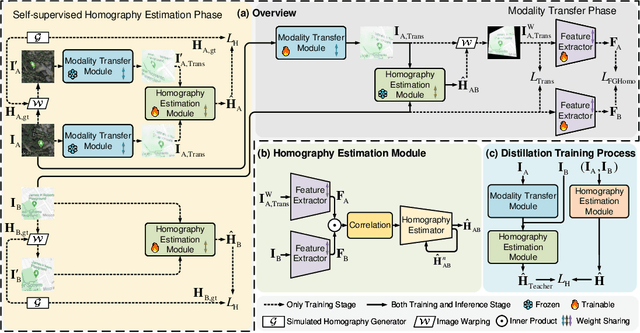
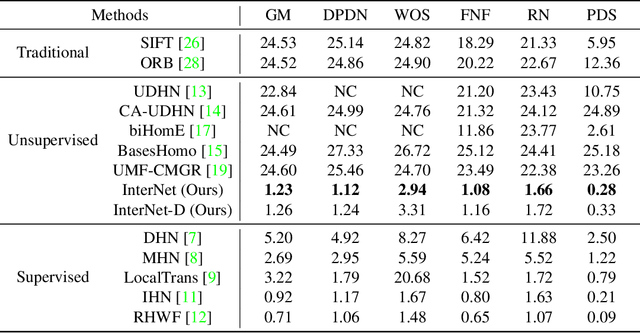
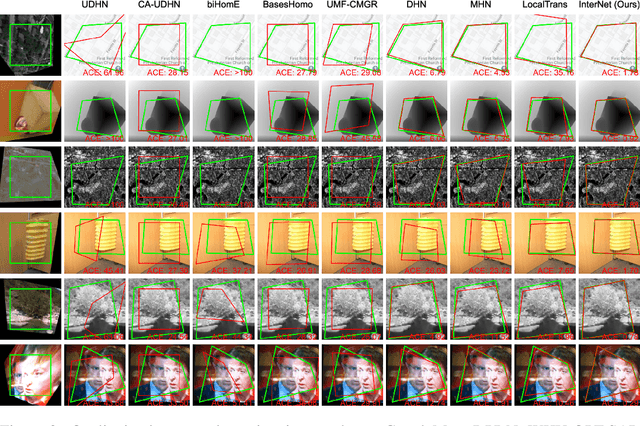

Abstract:We propose a novel unsupervised cross-modal homography estimation framework, based on interleaved modality transfer and self-supervised homography prediction, named InterNet. InterNet integrates modality transfer and self-supervised homography estimation, introducing an innovative interleaved optimization framework to alternately promote both components. The modality transfer gradually narrows the modality gaps, facilitating the self-supervised homography estimation to fully leverage the synthetic intra-modal data. The self-supervised homography estimation progressively achieves reliable predictions, thereby providing robust cross-modal supervision for the modality transfer. To further boost the estimation accuracy, we also formulate a fine-grained homography feature loss to improve the connection between two components. Furthermore, we employ a simple yet effective distillation training technique to reduce model parameters and improve cross-domain generalization ability while maintaining comparable performance. Experiments reveal that InterNet achieves the state-of-the-art (SOTA) performance among unsupervised methods, and even outperforms many supervised methods such as MHN and LocalTrans.
AddressCLIP: Empowering Vision-Language Models for City-wide Image Address Localization
Jul 11, 2024



Abstract:In this study, we introduce a new problem raised by social media and photojournalism, named Image Address Localization (IAL), which aims to predict the readable textual address where an image was taken. Existing two-stage approaches involve predicting geographical coordinates and converting them into human-readable addresses, which can lead to ambiguity and be resource-intensive. In contrast, we propose an end-to-end framework named AddressCLIP to solve the problem with more semantics, consisting of two key ingredients: i) image-text alignment to align images with addresses and scene captions by contrastive learning, and ii) image-geography matching to constrain image features with the spatial distance in terms of manifold learning. Additionally, we have built three datasets from Pittsburgh and San Francisco on different scales specifically for the IAL problem. Experiments demonstrate that our approach achieves compelling performance on the proposed datasets and outperforms representative transfer learning methods for vision-language models. Furthermore, extensive ablations and visualizations exhibit the effectiveness of the proposed method. The datasets and source code are available at https://github.com/xsx1001/AddressCLIP.
Understand What LLM Needs: Dual Preference Alignment for Retrieval-Augmented Generation
Jun 26, 2024Abstract:Retrieval-augmented generation (RAG) has demonstrated effectiveness in mitigating the hallucination problem of large language models (LLMs). However, the difficulty of aligning the retriever with the diverse LLMs' knowledge preferences inevitably poses an inevitable challenge in developing a reliable RAG system. To address this issue, we propose DPA-RAG, a universal framework designed to align diverse knowledge preferences within RAG systems. Specifically, we initially introduce a preference knowledge construction pipline and incorporate five novel query augmentation strategies to alleviate preference data scarcity. Based on preference data, DPA-RAG accomplishes both external and internal preference alignment: 1) It jointly integrate pair-wise, point-wise, and contrastive preference alignment abilities into the reranker, achieving external preference alignment among RAG components. 2) It further introduces a pre-aligned stage before vanilla Supervised Fine-tuning (SFT), enabling LLMs to implicitly capture knowledge aligned with their reasoning preferences, achieving LLMs' internal alignment. Experimental results across four knowledge-intensive QA datasets demonstrate that DPA-RAG outperforms all baselines and seamlessly integrates both black-box and open-sourced LLM readers. Further qualitative analysis and discussions also provide empirical guidance for achieving reliable RAG systems. Our code is publicly available at https://github.com/dongguanting/DPA-RAG.
FlashRAG: A Modular Toolkit for Efficient Retrieval-Augmented Generation Research
May 22, 2024Abstract:With the advent of Large Language Models (LLMs), the potential of Retrieval Augmented Generation (RAG) techniques have garnered considerable research attention. Numerous novel algorithms and models have been introduced to enhance various aspects of RAG systems. However, the absence of a standardized framework for implementation, coupled with the inherently intricate RAG process, makes it challenging and time-consuming for researchers to compare and evaluate these approaches in a consistent environment. Existing RAG toolkits like LangChain and LlamaIndex, while available, are often heavy and unwieldy, failing to meet the personalized needs of researchers. In response to this challenge, we propose FlashRAG, an efficient and modular open-source toolkit designed to assist researchers in reproducing existing RAG methods and in developing their own RAG algorithms within a unified framework. Our toolkit implements 12 advanced RAG methods and has gathered and organized 32 benchmark datasets. Our toolkit has various features, including customizable modular framework, rich collection of pre-implemented RAG works, comprehensive datasets, efficient auxiliary pre-processing scripts, and extensive and standard evaluation metrics. Our toolkit and resources are available at https://github.com/RUC-NLPIR/FlashRAG.
Reusable Architecture Growth for Continual Stereo Matching
Mar 30, 2024



Abstract:The remarkable performance of recent stereo depth estimation models benefits from the successful use of convolutional neural networks to regress dense disparity. Akin to most tasks, this needs gathering training data that covers a number of heterogeneous scenes at deployment time. However, training samples are typically acquired continuously in practical applications, making the capability to learn new scenes continually even more crucial. For this purpose, we propose to perform continual stereo matching where a model is tasked to 1) continually learn new scenes, 2) overcome forgetting previously learned scenes, and 3) continuously predict disparities at inference. We achieve this goal by introducing a Reusable Architecture Growth (RAG) framework. RAG leverages task-specific neural unit search and architecture growth to learn new scenes continually in both supervised and self-supervised manners. It can maintain high reusability during growth by reusing previous units while obtaining good performance. Additionally, we present a Scene Router module to adaptively select the scene-specific architecture path at inference. Comprehensive experiments on numerous datasets show that our framework performs impressively in various weather, road, and city circumstances and surpasses the state-of-the-art methods in more challenging cross-dataset settings. Further experiments also demonstrate the adaptability of our method to unseen scenes, which can facilitate end-to-end stereo architecture learning and practical deployment.
Enhancing Visual Continual Learning with Language-Guided Supervision
Mar 24, 2024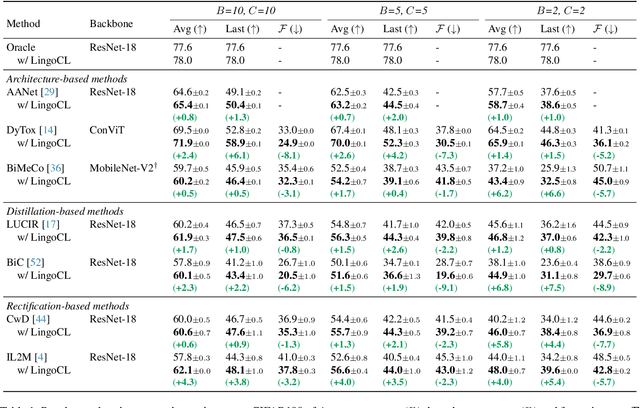
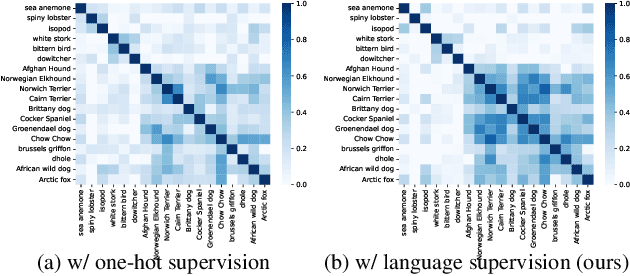
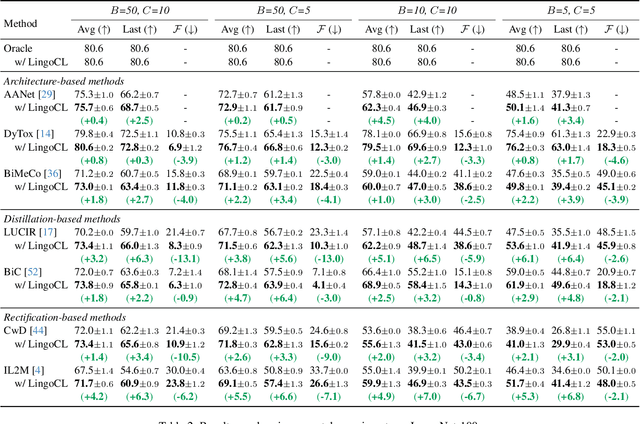
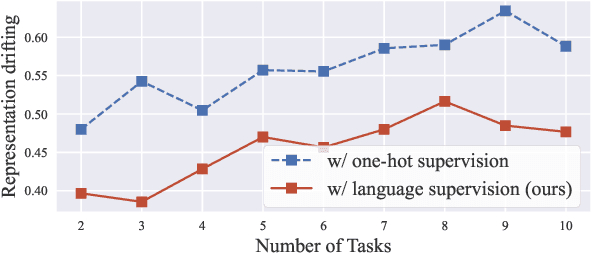
Abstract:Continual learning (CL) aims to empower models to learn new tasks without forgetting previously acquired knowledge. Most prior works concentrate on the techniques of architectures, replay data, regularization, \etc. However, the category name of each class is largely neglected. Existing methods commonly utilize the one-hot labels and randomly initialize the classifier head. We argue that the scarce semantic information conveyed by the one-hot labels hampers the effective knowledge transfer across tasks. In this paper, we revisit the role of the classifier head within the CL paradigm and replace the classifier with semantic knowledge from pretrained language models (PLMs). Specifically, we use PLMs to generate semantic targets for each class, which are frozen and serve as supervision signals during training. Such targets fully consider the semantic correlation between all classes across tasks. Empirical studies show that our approach mitigates forgetting by alleviating representation drifting and facilitating knowledge transfer across tasks. The proposed method is simple to implement and can seamlessly be plugged into existing methods with negligible adjustments. Extensive experiments based on eleven mainstream baselines demonstrate the effectiveness and generalizability of our approach to various protocols. For example, under the class-incremental learning setting on ImageNet-100, our method significantly improves the Top-1 accuracy by 3.2\% to 6.1\% while reducing the forgetting rate by 2.6\% to 13.1\%.
 Add to Chrome
Add to Chrome Add to Firefox
Add to Firefox Add to Edge
Add to Edge